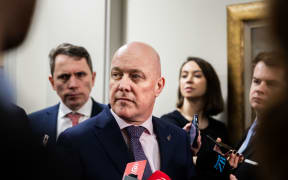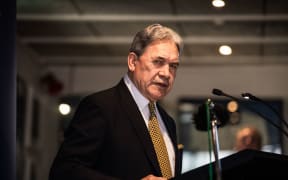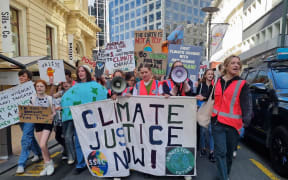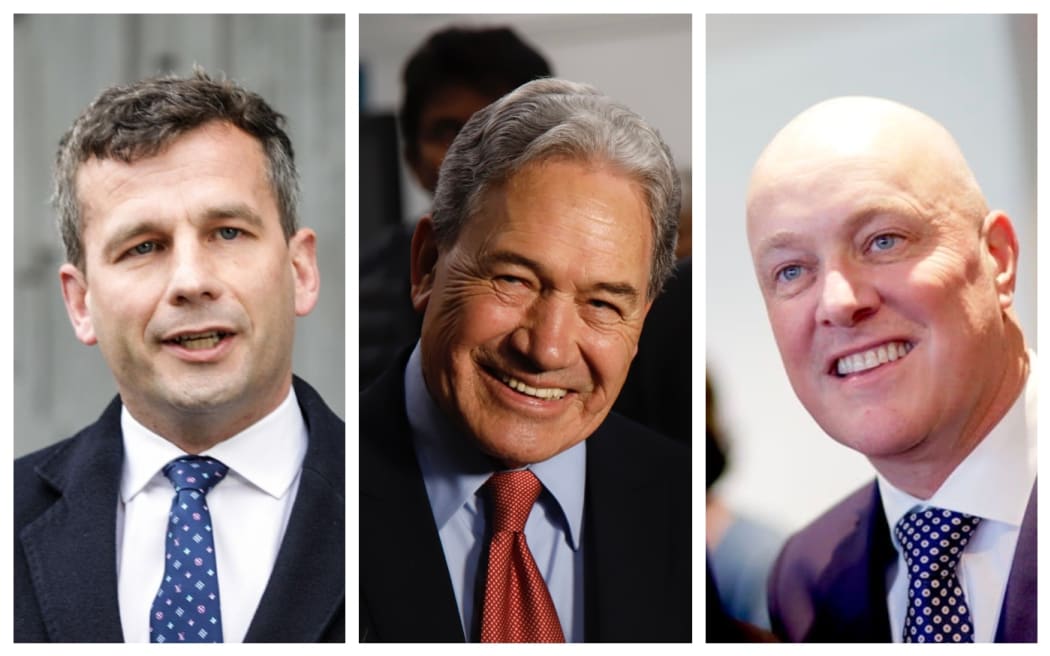
David Seymour, Winston Peters and Christopher Luxon. Photo: RNZ
Christopher Luxon's pre-election promise that New Zealand's climate targets were not on the table may be about to be tested.
National's pre-election statements were unequivocal that neither the Zero Carbon Act nor New Zealand's international climate pledges were up for negotiation.
ACT campaigned hard on repealing the Zero Carbon Act, though ACT's climate spokesperson Simon Court stopped short of saying the party would make it a bottom line in coalition negotiations.
NZ First leader Winston Peters, meanwhile, shared misinformation minimising human impact on the climate during the campaign.
National's climate spokesperson Simon Watts was firm when he told a climate and business conference in the election lead-up that the fundamentals of New Zealand's climate response were not up for discussion: the Zero Carbon Act, which created the independent Climate Change Commission (which advises the government on emissions budgets and other matters) and the government's international promise to halve net emissions by 2030 off 2005 gross levels.
However, there are two areas where National expressed more willingness to change things.
International purchases
One is buying international carbon credits to help meet the 2030 target. This is currently the plan for meeting New Zealand's climate promise under the Paris Agreement, because it is expected to be cheaper and less painful for the economy than meeting the whole 2030 target inside New Zealand.
Treasury has put the cost at anywhere from $3-$23 billion, though carbon market experts suggest it will be at the lower end. Government officials are due to report to Cabinet on how to go about this before Christmas.
National baulked at the potential cost of this during pre-election interviews, expressing a preference for meeting the target mostly with action inside New Zealand, but without detailing how this would be achieved or paid for.
National's policy is to divert most of the Climate Emergence Response Fund to tax cuts. The fund (from auctioning carbon credits to New Zealand polluters) could have helped fund the purchase of overseas credits and/or action to make extra carbon cuts inside New Zealand.
NZ First does not want money spent on climate action overseas, according to its website. ACT has expressed willingness to renege on the 2030 target, depending on the level of emissions cuts by New Zealand's biggest trading partners, despite the targets being built into two fair trade agreements.
It will be difficult to meet the international target of halving net emissions by 2030 without looking overseas, without bold new climate policies.
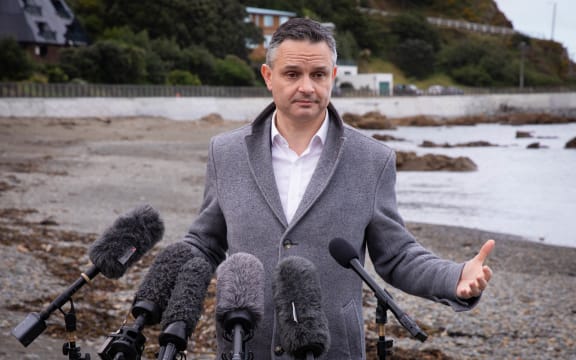
Outgoing Climate Change Minister James Shaw. Photo: RNZ / Angus Dreaver
Almost as soon as the new government has grappled with this, it will need to think about its target for the following five years.
The day before the election, the Climate Change Commission confirmed outgoing Climate Change Minister James Shaw had asked it to advise the government on the next international target, from 2030-2035. Part of the advice will cover the implications of trying to meet the whole lot within New Zealand.
That advice is not due until the end of 2024, with the next target due in 2025.

Cows are a big source of methane. Photo: RNZ/Alexander Robertson
Methane targets
The other area of possible wiggle room is methane targets, though it is not clear if National's policy would lead to any change.
ACT wants any cuts to farm emissions to be tied to cuts by a group of New Zealand's trading partners, including China. NZ First does not want farm emissions priced at all unless the other countries - and especially the European Union - does the same.
National's policy is to "review methane targets for consistency with no additional warming from agriculture".
The reference to 'no additional warming' refers to an idea (popular with farming lobby groups) that the heating created by New Zealand's farming methane should be stabilised, but should not have to reduce below current heating levels.
Farm groups argue this is fair, because heating caused by carbon dioxide (from cars, factories and other places) cannot stop rising until carbon emissions get to net zero, decades from now. That is for the simple physical reason that carbon dioxide lasts a long time in the atmosphere, so the tap needs to be turned off completely to stop heating from rising.
Methane is shorter-lived, so its heating can reduce or stabilise within a decade if the flow of emissions turns down even a little bit. That's why New Zealand's climate targets allow for partial cuts, rather than a complete stop.
But the science is clear that levelling-off heating means some level of cuts to methane emissions. And there is fierce debate about whether keeping heating from farming at current levels is fair, given how much of New Zealand's contribution to climate change is caused by farming emissions.
Methane has caused most of New Zealand's contribution to heating so far, both because it acts more quickly than carbon dioxide and because the country has a lot of cows and sheep per person.
Exactly what a review would find depends on when 'no additional warming' is measured from, and what the rest of the world is doing.
The current targets are to cut methane 10 percent by 2030 and 24-47 percent by 2050.
A scientific review commissioned by Parliamentary Commissioner Simon Upton in 2018 found if methane was kept at 2016 levels, New Zealand farms would still keep increasing the amount of heating they were making year-to-year, because of the physical flow-on effects of stable emissions of methane.
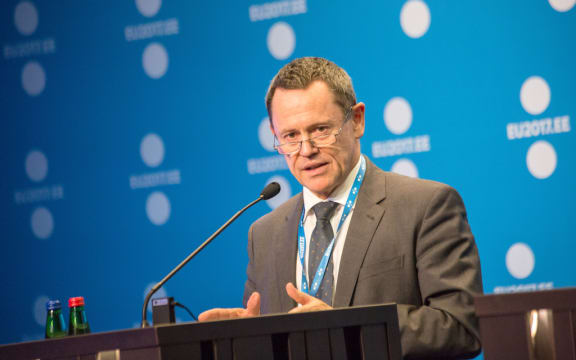
Simon Upton. Photo: [https://www.flickr.com/photos/eu2017ee/35725837402flickr]
To keep the level of heating stable, farmers would need to shave off 10-22 percent by 2050, but most of this - up to a 20 percent cut - would need to happen by 2030, if the world was on track to stay inside 2C heating. In other words, getting to 'no additional warming' could mean being tougher on methane than the current 10 percent target, depending what was happening in the world.
Upton also stressed that he was not saying 'no additional warming' was a good or fair target. New Zealand's methane from farming has risen significantly since 1990, but began to dip recently. (Heating from nitrous oxide, also from farming, has shown a similar pattern - nitrous oxide is long-lived, and about a tenth of the country's emissions.)
More recently, a scientific report commissioned by DairyNZ, Federated Farmers and Beef + Lamb found that keeping the heating caused by farming's methane steady at 2020 levels would take a 15 percent-27 percent cut by 2050, based on the rest of the world taking climate action at a moderate pace (requiring cuts at the lower end of the range) or faster (the higher end).
How much methane to heating matters depends on overall global emissions levels. To stabilise methane's contribution at 2017 heating levels would take deeper cuts, the researchers said.
Reducing the methane targets could require other sectors of the economy to cut emissions more, particularly from 2030, in order to meet climate targets. Currently, emissions from consumer products such as petrol and electricity are affected by a carbon price, but agricultural emissions will remain price-free until 2030 at the latest under National's policy.
